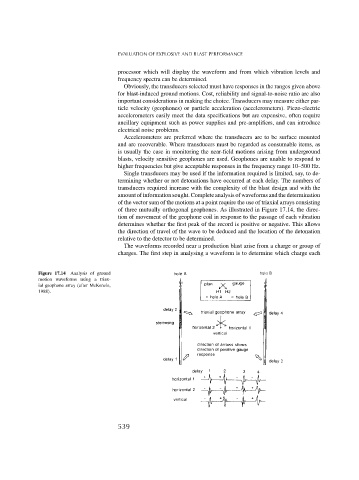Page 557 - Rock Mechanics For Underground Mining
P. 557
EVALUATION OF EXPLOSIVE AND BLAST PERFORMANCE
processor which will display the waveform and from which vibration levels and
frequency spectra can be determined.
Obviously, the transducers selected must have responses in the ranges given above
for blast-induced ground motions. Cost, reliability and signal-to-noise ratio are also
important considerations in making the choice. Transducers may measure either par-
ticle velocity (geophones) or particle acceleration (accelerometers). Piezo-electric
accelerometers easily meet the data specifications but are expensive, often require
ancillary equipment such as power supplies and pre-amplifiers, and can introduce
electrical noise problems.
Accelerometers are preferred where the transducers are to be surface mounted
and are recoverable. Where transducers must be regarded as consumable items, as
is usually the case in monitoring the near-field motions arising from underground
blasts, velocity sensitive geophones are used. Geophones are unable to respond to
higher frequencies but give acceptable responses in the frequency range 10–500 Hz.
Single transducers may be used if the information required is limited, say, to de-
termining whether or not detonations have occurred at each delay. The numbers of
transducers required increase with the complexity of the blast design and with the
amount of information sought. Complete analysis of waveforms and the determination
of the vector sum of the motions at a point require the use of triaxial arrays consisting
of three mutually orthogonal geophones. As illustrated in Figure 17.14, the direc-
tion of movement of the geophone coil in response to the passage of each vibration
determines whether the first peak of the record is positive or negative. This allows
the direction of travel of the wave to be deduced and the location of the detonation
relative to the detector to be determined.
The waveforms recorded near a production blast arise from a charge or group of
charges. The first step in analysing a waveform is to determine which charge each
Figure 17.14 Analysis of ground
motion waveforms using a triax-
ial geophone array (after McKenzie,
1988).
539

